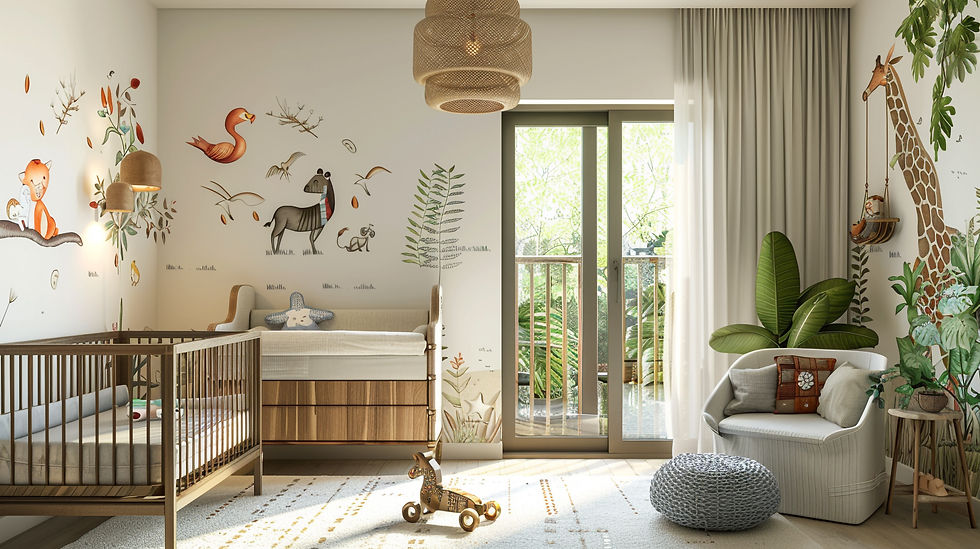Decorative Finishes Comparison: Transforming Your Space with Style
- Melanie Aldana
- Jul 9, 2024
- 3 min read
Updated: Oct 14, 2024

When it comes to home decor, the finishes you choose can dramatically transform the look and feel of your space. From the walls to the floors, the right materials can add personality, enhance functionality, and even increase the value of your home. In this blog, we'll explore various decorative finishes, comparing their pros, cons, and best uses to help you make informed decisions for your next renovation project.
1. Paint vs. Wallpaper
Paint:
Pros: Versatile, easy to apply, cost-effective, and simple to change.
Cons: Can be less durable and may require frequent touch-ups.
Best For: A quick and easy way to refresh a room, ideal for DIY projects.
Wallpaper:
Pros: Adds texture and patterns, long-lasting, hides imperfections.
Cons: More expensive and difficult to remove and replace.
Best For: Adding a statement wall or intricate design without the need for artwork.
When deciding between paint and wallpaper, consider the room's purpose and the amount of effort you're willing to put into maintenance. Paint is perfect for those who like to change their decor frequently, while wallpaper is great for creating bold, lasting impressions.
2. Tiles vs. Wood Panels
Tiles:

Pros: Water-resistant, durable, and available in various colors and patterns.
Cons: Can be cold and hard, and grout requires maintenance.
Best For: Bathrooms, kitchens, and high-traffic areas where durability and ease of cleaning are key.
Wood Panels:
Pros: Adds warmth and texture, can be painted or stained, with eco-friendly options available.
Cons: Susceptible to moisture damage and can be more expensive.
Best For: Living rooms, bedrooms, and spaces where a cozy, rustic feel is desired.
Choose tiles for practicality in wet and busy areas, and opt for wood panels to create inviting, intimate spaces.
3. Crown Molding vs. Baseboards
Crown Molding:
Pros: Enhances architectural interest, adds elegance, and hides ceiling imperfections.
Cons: Can be pricey and requires precise installation.
Best For: Formal living areas, dining rooms, and spaces where you want to add a touch of sophistication.
Baseboards:
Pros: Protects walls from damage, easy to install, and enhances room appearance.
Cons: Can accumulate dust and may require painting.
Best For: Every room as a finishing touch that protects and beautifies the base of walls.
Both crown molding and baseboards add polish to a room. Crown molding brings a grand, finished look to formal spaces, while baseboards provide practical protection and aesthetic appeal in any room.
4. Wainscoting vs. Beadboard
Wainscoting:
Pros: Adds elegance, protects walls, with customizable height and styles.
Cons: Can be expensive and labor-intensive to install.
Best For: Dining rooms, entryways, and formal spaces needing a traditional look.
Beadboard:
Pros: Casual, cottage-like appearance, easier to install, and cost-effective.
Cons: Limited to specific design styles and less formal.
Best For: Bathrooms, kitchens, and casual living areas where a cozy, country feel is desired.
Wainscoting brings a classic, upscale feel, perfect for formal settings, while beadboard offers a relaxed, charming vibe ideal for casual spaces.
5. Stenciling vs. Decals
Stenciling:
Pros: Customizable, long-lasting, and offers artistic and unique designs.
Cons: Time-consuming and requires precision.
Best For: Personalized touches in any room, ideal for DIY enthusiasts looking for a creative project.
Decals:

Pros: Easy to apply and remove, with a wide variety of designs, and no painting skills needed.
Cons: May not last as long and can peel over time.
Best For: Renters or anyone wanting to add temporary decoration without a long-term commitment.
Stenciling is great for those who enjoy hands-on projects and want a bespoke look, whereas decals are perfect for temporary, flexible decor solutions.
6. Venetian Plaster vs. Textured Paint
Venetian Plaster:
Pros: Luxurious, highly durable, and creates a marble-like finish.
Cons: Expensive and requires professional application.
Best For: High-end renovations and feature walls in living rooms or hallways.
Textured Paint:
Pros: Hides wall imperfections, adds depth, and is more affordable.
Cons: Harder to repaint or remove and can be difficult to apply evenly.
Best For: Adding interest to ceilings or accent walls without breaking the bank.
Venetian plaster offers a high-end, elegant finish, suitable for luxury interiors, while textured paint provides a cost-effective way to add dimension and interest to any space.
By comparing these decorative finishes, you can select the best options that align with your design goals, budget, and the specific needs of each room in your home. Whether you’re aiming for a modern, sleek look or a cozy, rustic feel, the right finishes can transform your space with style and functionality. Happy decorating!



